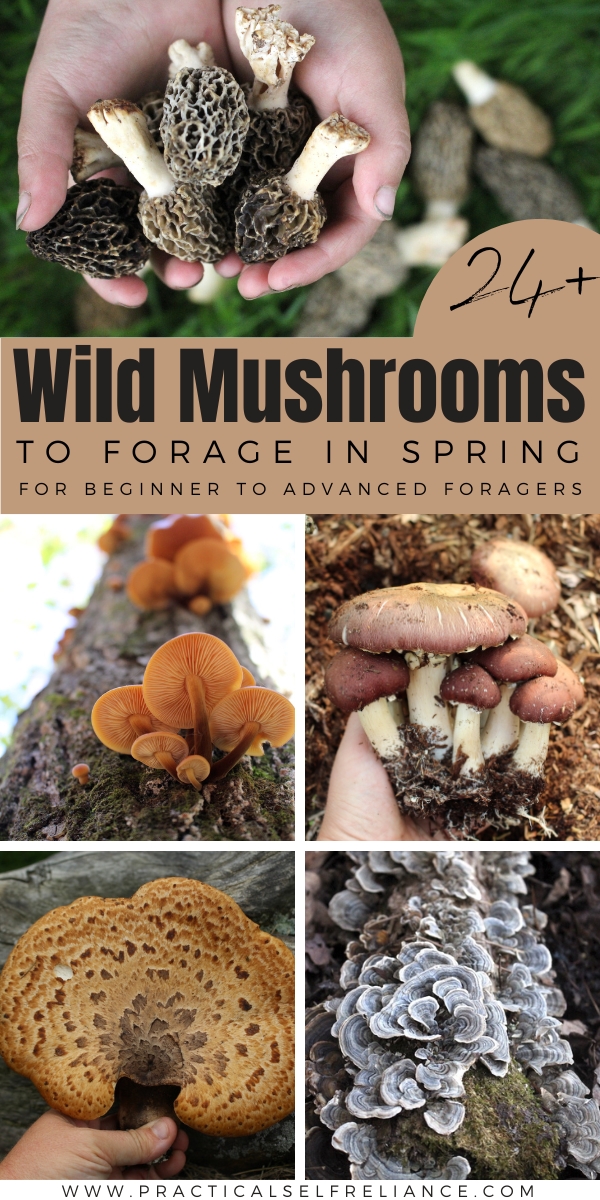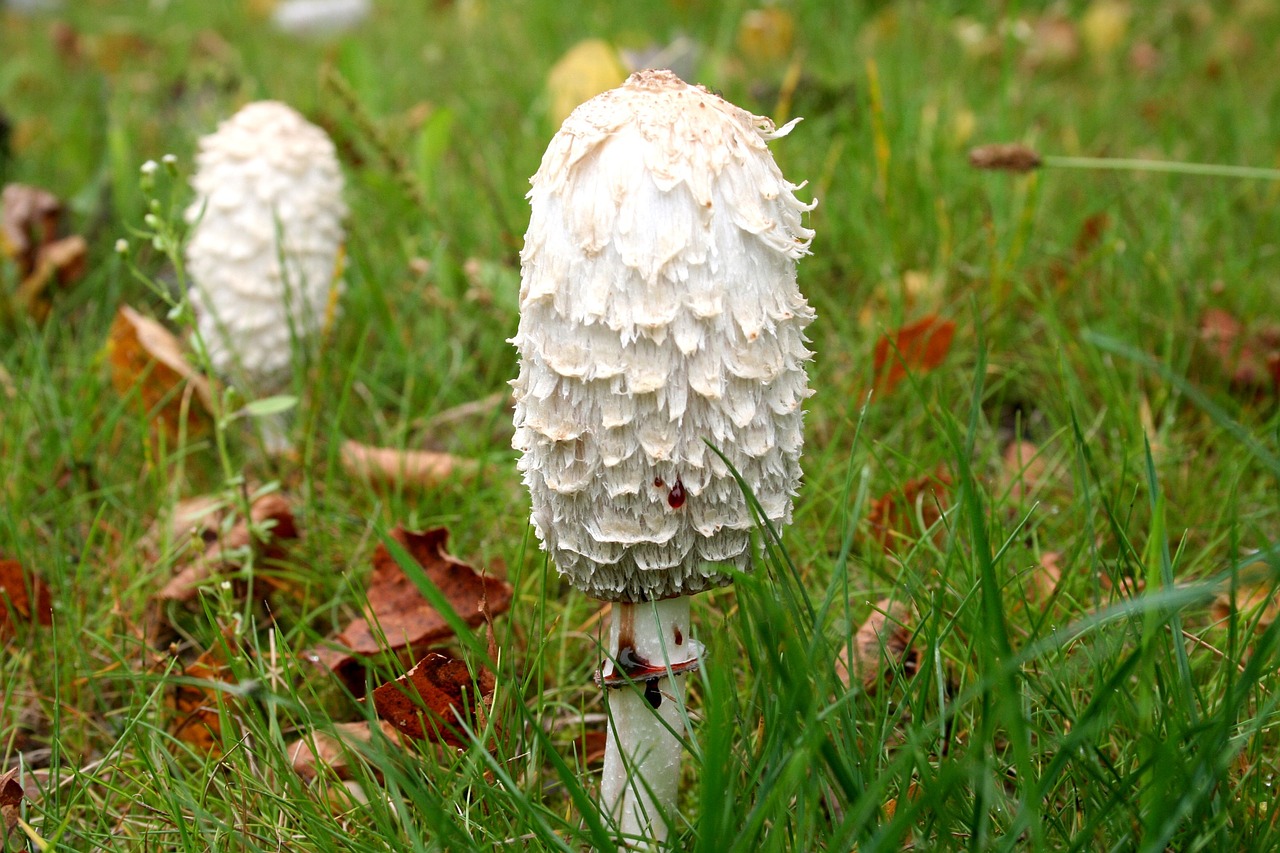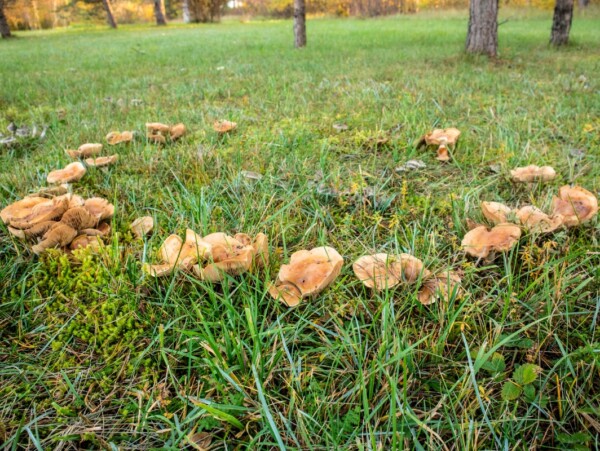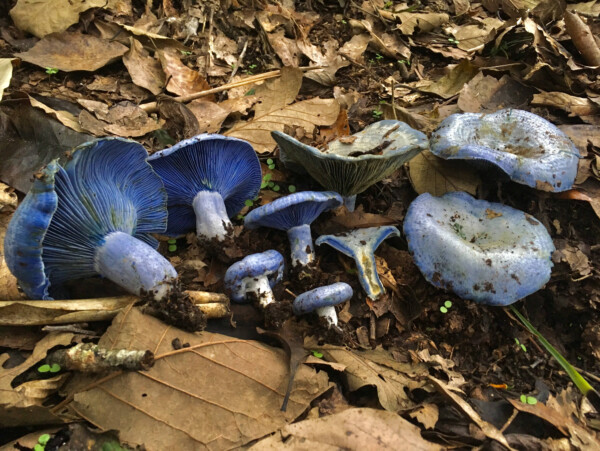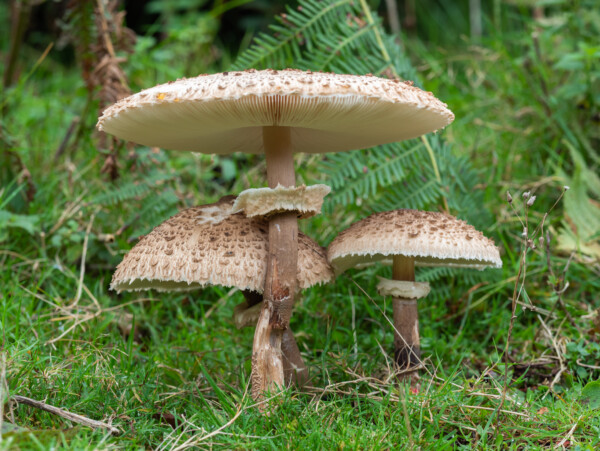Affiliate disclosure: This post may contain affiliate links. Please see our Privacy Policy.
Spring mushroom foraging is a great excuse to get outside and harvest something tasty. Some of the world’s most expensive mushrooms thrive in early spring, and you can harvest these exquisite tastes for yourself!
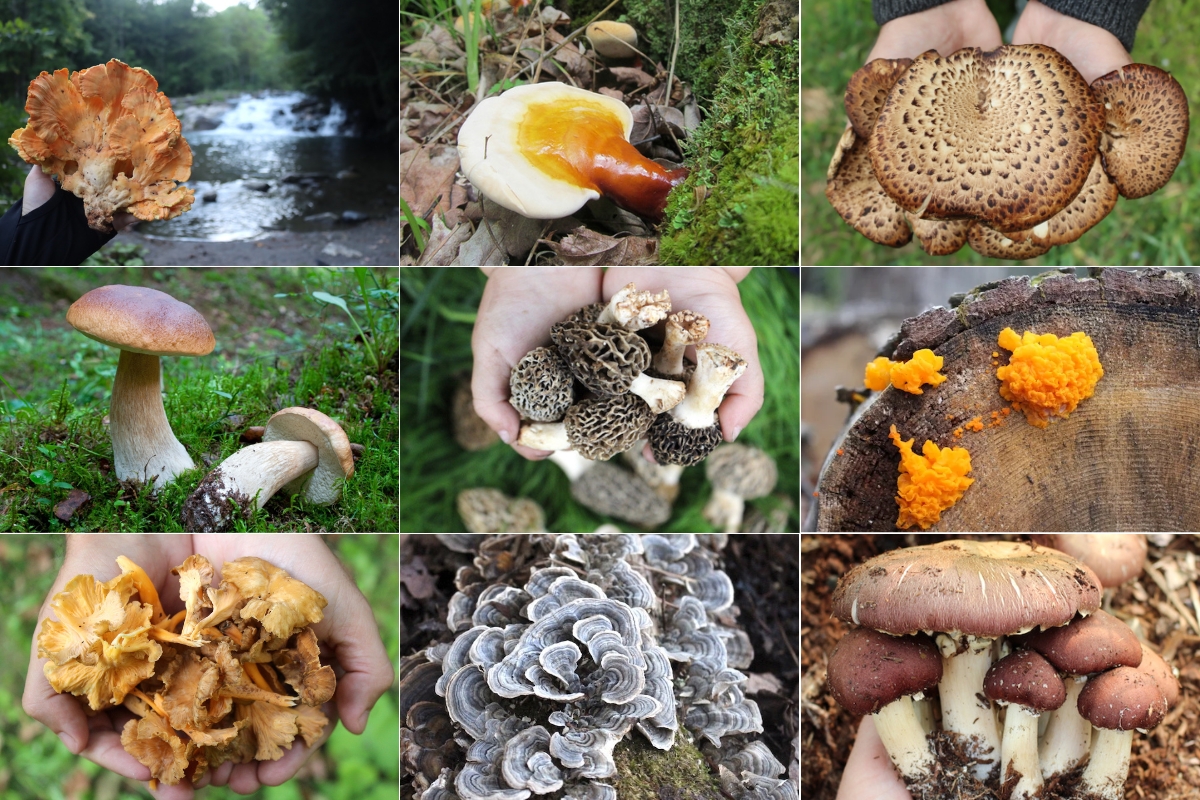
In spring, we often zone in on the profusion of greens and wildflowers bursting into life around us. The spring abundance doesn’t stop there, though. As air and soil temperatures begin to warm and abundant rainfall creates moist conditions, we start to see flushes of mushrooms. Mushrooms may seem scary, but with a bit of knowledge, even beginner foragers can safely harvest spring mushrooms.
Spring’s optimum growing conditions create an abundance of all sorts of wild food, including mushrooms.
Exactly what is available will depend on your climate and seasonal variation. However, no matter where you live, spring is a great time to be in the woods hunting for mushrooms.
Spring Mushroom Species
The exact season for any type of mushroom can fluctuate widely with location, climate, and yearly weather variation. In southern areas, some of these species may pop up in late winter or very early spring. In northern areas like New England, they may not appear until May or even June.
Some of these species, like oyster mushrooms, fruit during the cooler temperatures of early spring but may provide an additional flush as temperatures drop in the fall.
Others, like chicken of the woods, begin producing as the temperatures warm up and continue fruiting during parts of the summer.
Some of the mushrooms you can find during the spring are culinary mushrooms, while others are powerful medicinals.
Generally, these are some of the mushroom species that you can find in spring:
Beginner Foragers
- Morel Mushrooms (Morchella spp.)
- Pheasant Back Mushroom (Cerioporus squamosus)
- Shaggy Mane Mushrooms (Coprinus comatus)
- Black Trumpet Mushrooms (Craterellus cornucopioides)
- Wine Cap Mushrooms (Stropharia rugosoannulata)
- Chicken of the Woods (Laetiporus sulphureus)
- Scarlet Elf Cups (Sarcoscypha austriaca)
- Birch Polypore (Fomitopsis betulina)
- Tinder Polypore (Fomes fomentarius)
- Witches Butter Mushrooms (Dacrymyces palmatus)
- Reishi Mushrooms (Ganoderma sp.)
Intermediate Foragers
- Oyster Mushrooms (Pleurotus sp.)
- Turkey Tail Mushrooms (Trametes versicolor)
- Yellowfoot Chantarelles (Craterellus tubaeformis)
- Chantarelle Mushrooms (Craterellus spp.)
- Boletes (Boletus sp.)
- Wood Ear Mushrooms (Auricularia sp.)
- Deer Mushrooms (Pluteus cervinus and Pluteus pestatus)
- Common Split Gill Mushrooms (Schizophyllum commune)
- Spring Agaric Mushrooms (Agaricus bitorquis)
Advanced Foragers
- Caesar Mushrooms (Amanita caesarea, and other edible amanita species)
- Velvet Foot or Wild Enoki (Flammulina velutipes)
- False Morels (Gyromitra spp.)
- Spring Amanitas (Amanita velosa)
I’ll go through what you need to know about each of these mushrooms and provide identification guides.
Beginner Spring Mushrooms
These mushrooms are perfect for beginning foragers. They’re all easy to identify, and most are quite common across the enture US, making them perfect for foragers just getting started with the craft.
Morel Mushrooms (Morchella spp.)
Morels (Morchella spp.) are the quintessential spring mushrooms, and for good reason. They are renowned for their incredible flavor, and their hopeful sighting each early spring sends even the most reluctant foragers to the woods. You can sometimes spot them in farmer’s markets, and they regularly range from $20 to $50 per pound, but sometimes more. That’s how good they are!
Unfortunately, morel mushrooms are tricky to find and expertly blend in with the forest floor. Mistaking one for a dried leaf is easy until you give it your full attention.
Thankfully, we know a bit about where they like to grow, and with a little practice, you’ll be able to spot them and add their earthy, nutty flavor to your own spring dishes!
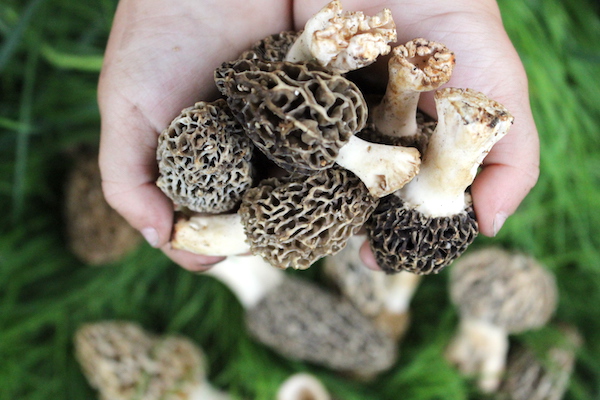
Pheasant Back Mushroom (Cerioporus squamosus)
Pheasant Back mushrooms (also called Dryad’s Saddles) are distinctive-looking mushrooms with a pattern of dark marks across their tan backs made from thin scales. They form on dead hardwood trees.
They’re great for beginners to forage because they have no toxic lookalikes. They also tend to produce on the same log for years, so you’ll usually get to harvest them for several seasons.
These mushrooms can reach enormous sizes, but they’re best when they’re tender and small. The young mushrooms are excellent sauteed in olive oil with garlic and a splash of lemon juice. The older mushrooms get tough but still make a delicious broth.
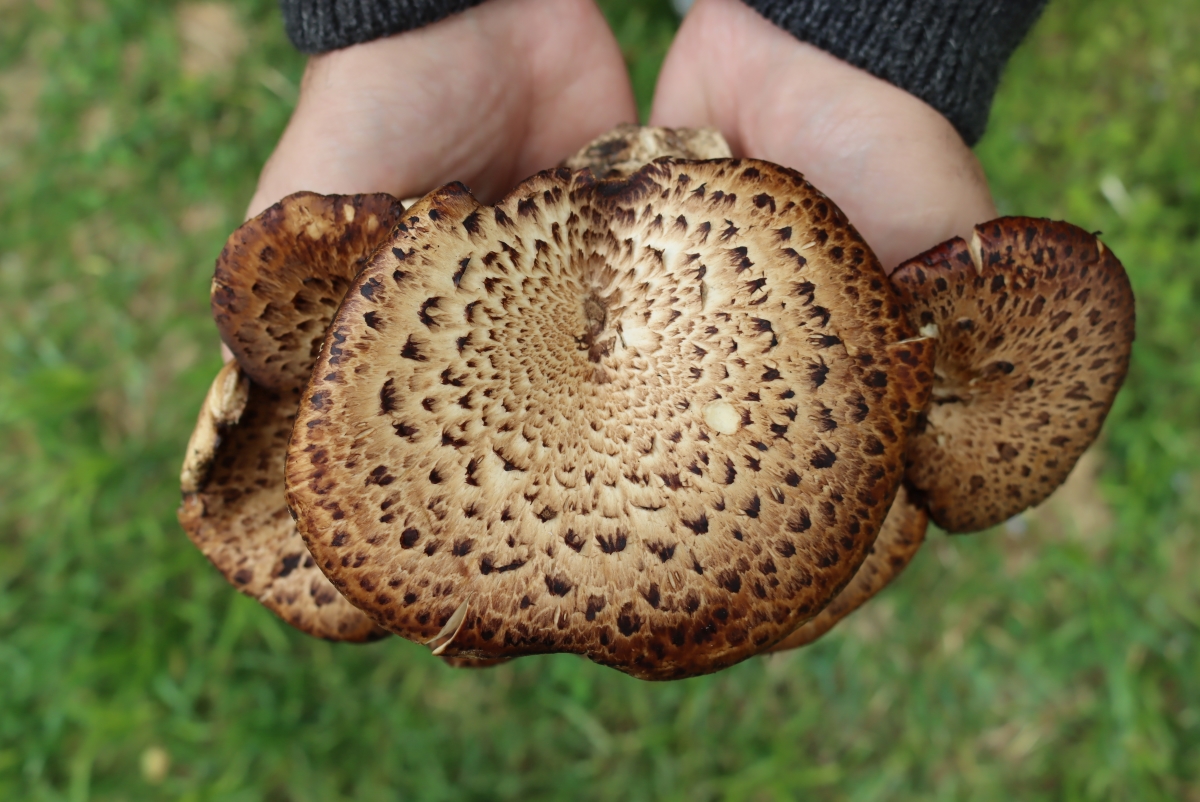
Shaggy Mane Mushrooms (Coprinus comatus)
Shaggy Mane mushrooms (Coprinus comatus)are easy to identify. They have cone-shaped caps with noticeable shaggy scales in gray, tan, or reddish brown. They’re sometimes called lawyer’s wigs as they look a bit like the old-fashioned court wigs.
These funny-looking mushrooms are also a great choice for urban foragers as they often grow on degraded or compacted soil.
However, you must use your harvest quickly, or the mushrooms begin disintegrating. They’re fun to use in creamy dishes like risotto, where they add striking black color.
Black Trumpet Mushrooms (Craterellus cornucopioides)
Black Trumpet mushrooms (Craterellus cornucopioides) are easy to identify and delicious. Their lack of toxic lookalikes makes them a great choice for beginner foragers.
Black trumpets grow on forest floors throughout the Northern Hemisphere. They have mycorrhizal relations with a number of trees, including oaks, hemlocks, and beeches. Unfortunately, their appearance blends in well with the forest floor and can make them difficult to find.
I don’t generally find black trumpets here in Vermont until the summer and fall. However, you can find them in spring in the southern Appalachians.
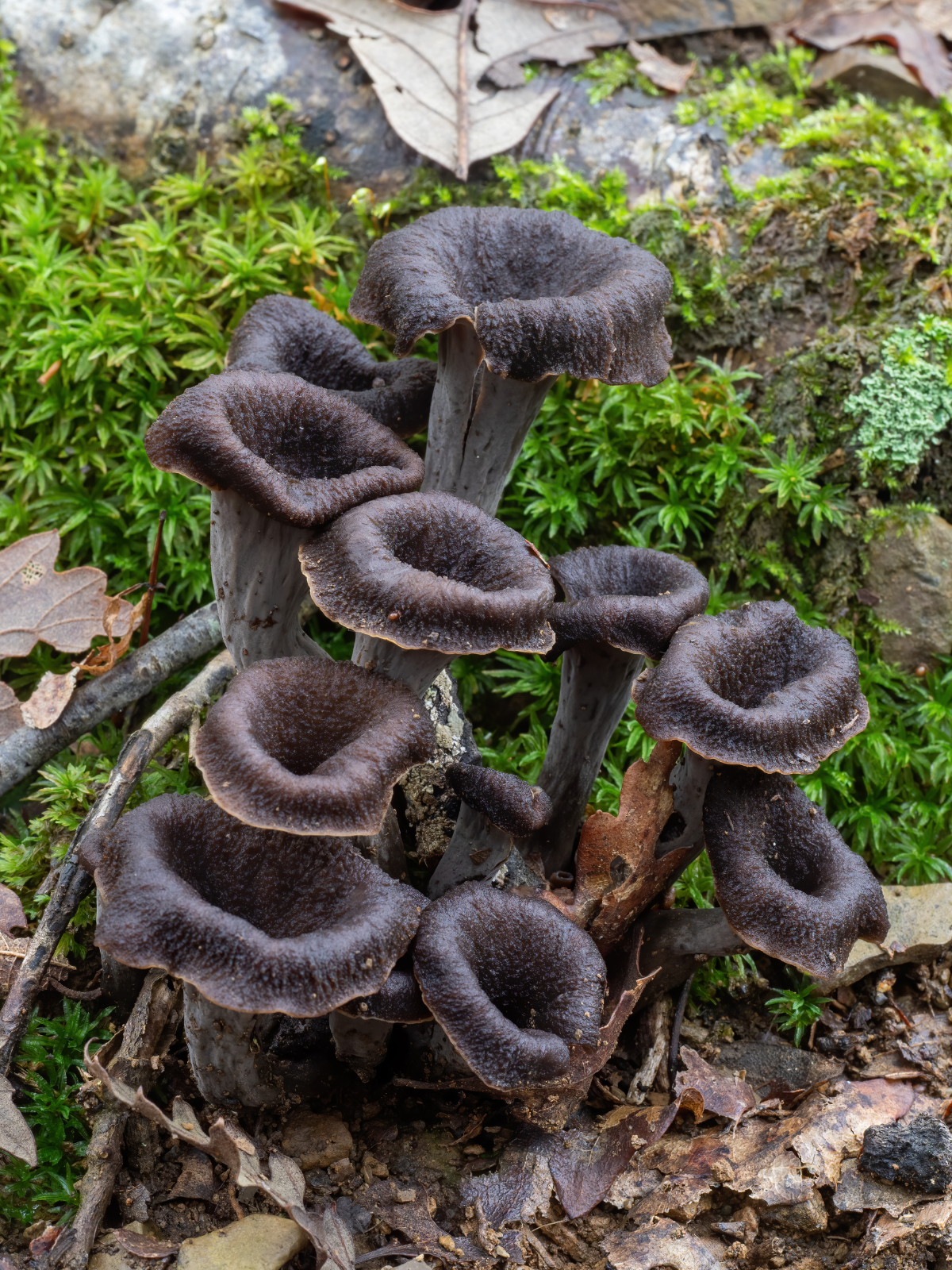
Wine Cap Mushrooms (Stropharia rugosoannulata)
Wine Caps are great mushrooms for urban foragers. They break down dead wood and plant material and often fruit on woodchips in parks and playgrounds.
Their caps begin as a dark burgundy red but fade to tan as they age. They’re as tasty as they are attractive and are wonderful grilled or cooked with bacon as a side dish.
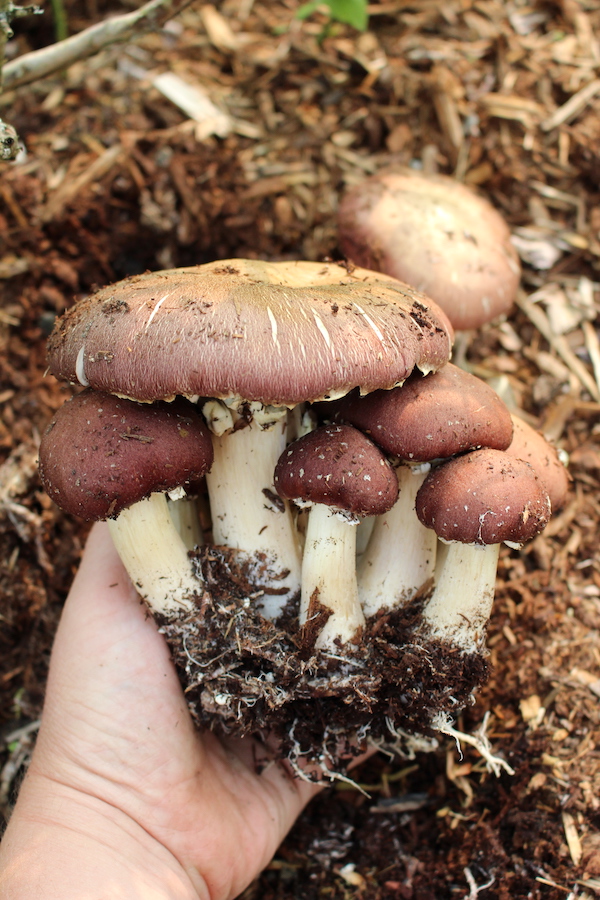
Chicken of the Woods (Laetiporus sulphureus)
Few other mushrooms have such appropriate names. Dredge these mushrooms in a bit of flour and fry them, and you’ll get something that tastes incredibly similar to chicken breast. They even have great texture!
Chicken of the woods are also among the easiest, safest mushrooms for beginners to learn to identify. They form large orange clusters of shelf mushrooms that are easy to spot from a distance.
These tasty mushrooms grow on dead or dying wood. We usually find them in Vermont in late summer, but they are also found in spring in warm years. In southern and Western regions, you’ll consistently spot them fruiting in spring.
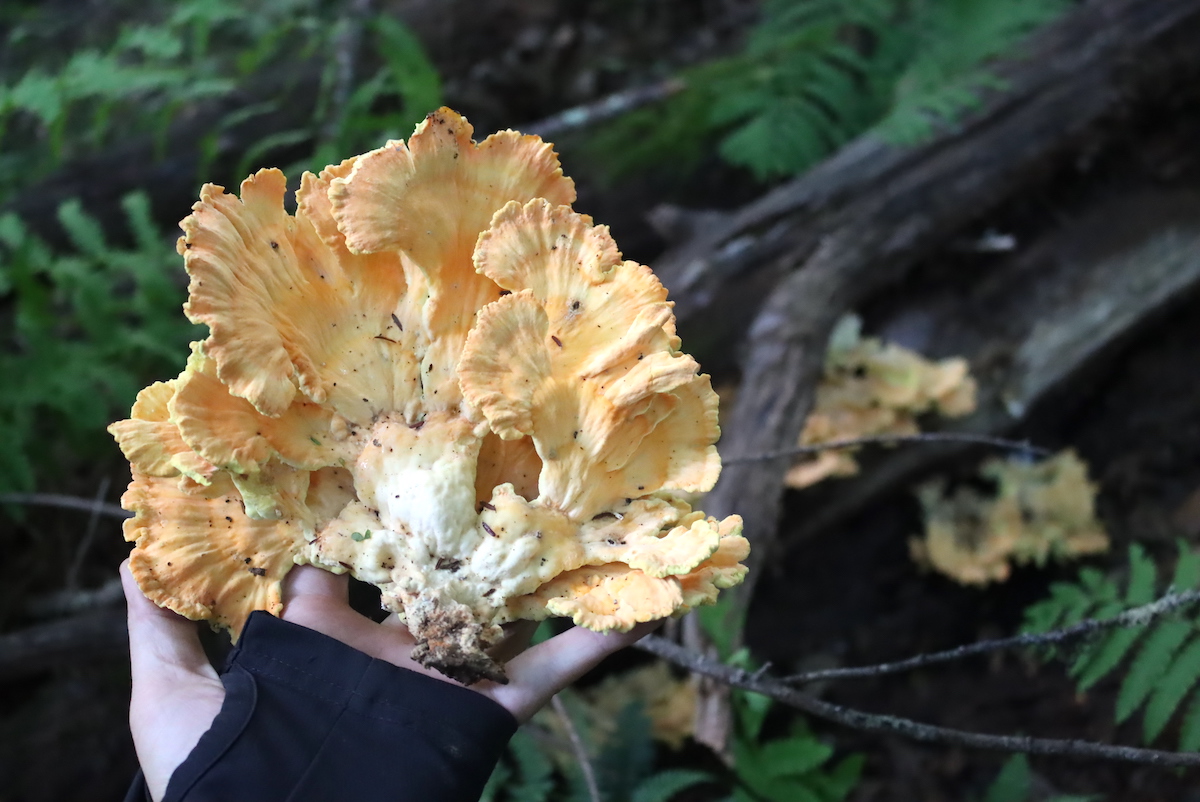
Scarlet Elf Cups
These brilliant red, tiny, cup-shaped mushrooms look like they belong in a fairy tale. They grow on dead, decaying logs, sometimes hiding beneath piles of leaf litter.
They’re an easy mushroom for beginners to positively identify. Their only lookalike is the Ruby Elfcup (Sarcosypha coccinea). Ruby elf cups are also edible and so nearly identical to scarlet cups that guidebooks sometimes confuse them.
Scarlet cups are tasty but need to be cooked before eating. They are excellent when lightly fried and make a fun, colorful garnish.
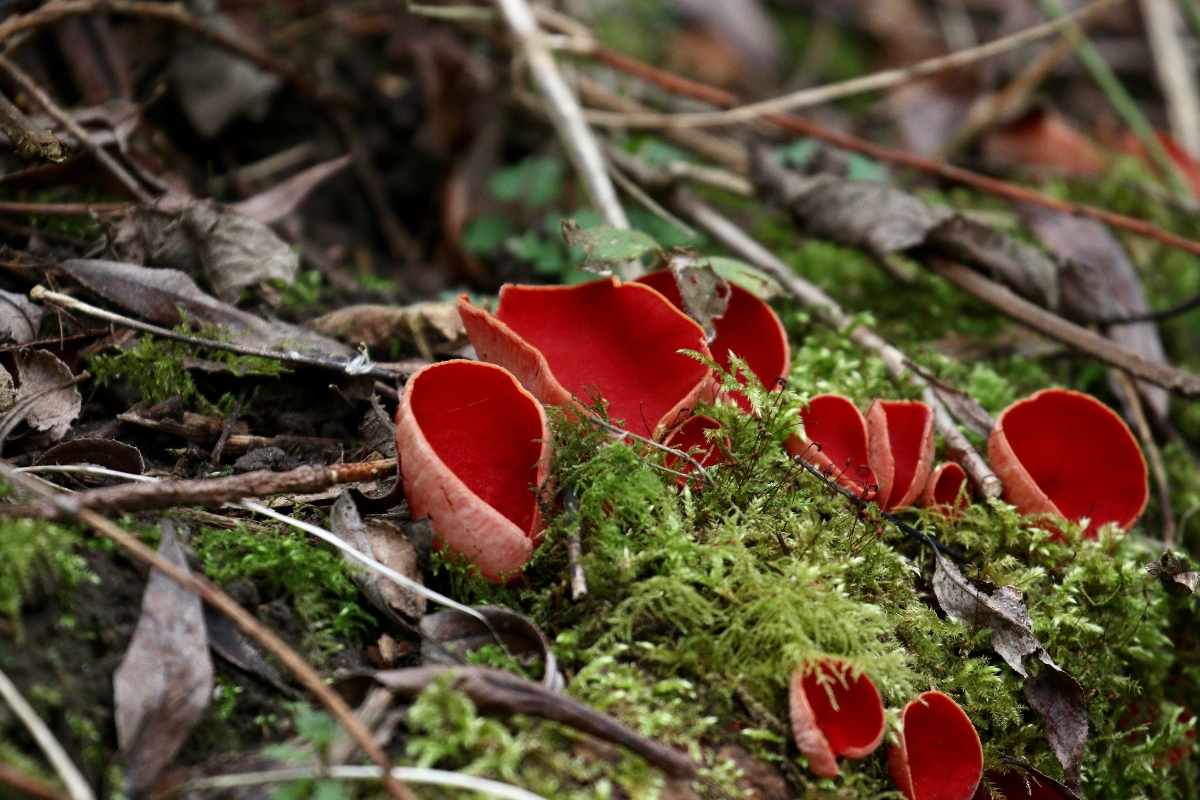
Birch Polypore
Birch polypore (Fomitopsis betulina) only grows on birch trees, making it an excellent choice for beginning foragers. This hoof-shaped mushroom parasitizes living birch trees, persisting on them until they rot away into soil.
Though not a tasty mushroom to eat, the birch polypore is a potent herbal remedy with antifungal, antiparasitic, and antiseptic properties. It’s also a helpful material and has been used as tinder and to sharpen razors.
This mushroom got a bit of fame among herbalists and archeology enthusiasts. Scientists found a birch polypore on a cord around the neck of Ötzi the Iceman, a 5,000-year-old mummy found in the Italian Alps. They theorize that he may have been using it as an antiparasitic to treat a parasite he carried called whipworm.
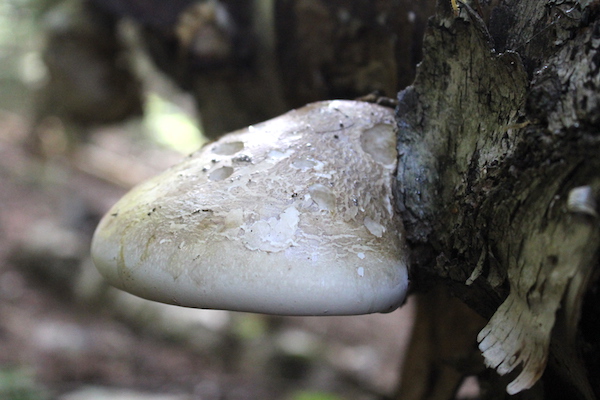
Tinder Polypore (Fomes fomentarius)
You can find this parasitic fungus on dying hardwood trees. Tinder polypore infects the trees and causes rot.
Tinder polypore is a medicinal mushroom with a long history of use that connects us to the past. As its name suggests, it has long been used as tinder for starting fires. Ötzi the Iceman, a 5,000-year-old mummy found in the Italian Alps, was carrying four pieces of tinder polypore, probably for lighting fires.
As a medicinal herb, tinder polypore has antioxidant, antibacterial, and anti-inflammatory properties. It may also be anti-diabetic.
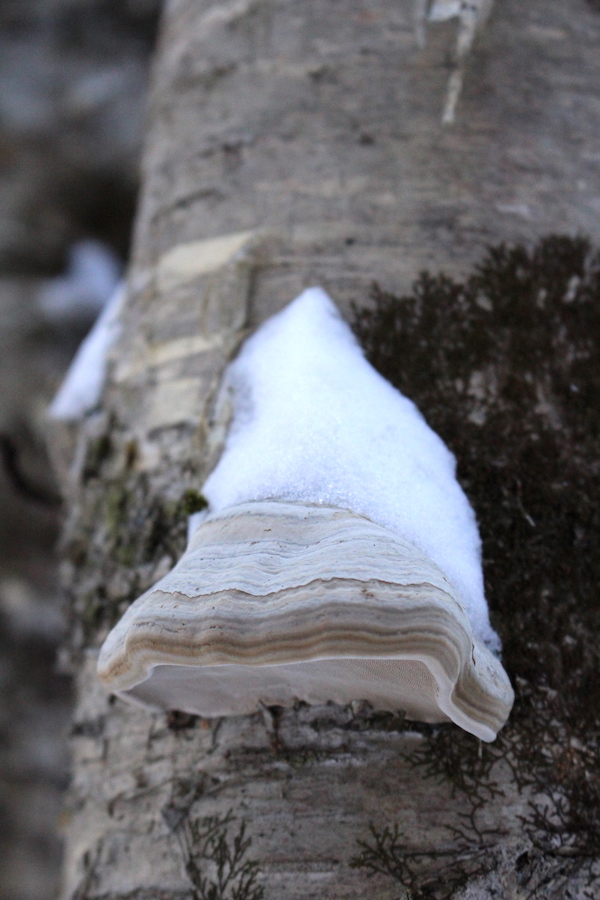
Witches Butter Mushrooms (Dacrymyces palmatus)
Witches Butter mushrooms (Dacrymyces palmatus) can pop up any time of year, and their bright yellow or orange coloring makes them hard to miss! They have jelly-like bodies and grow on dead trees and logs.
There are three species of mushroom that are all called witches’ butter. All three are edible and easy to identify.
Witches Butter mushrooms don’t have much flavor, but their year-round availability makes them a great survival food to recognize for anyone who spends time in the woods. They are also medicinal and may have anti-tumor properties and the ability to help fight respiratory infections.
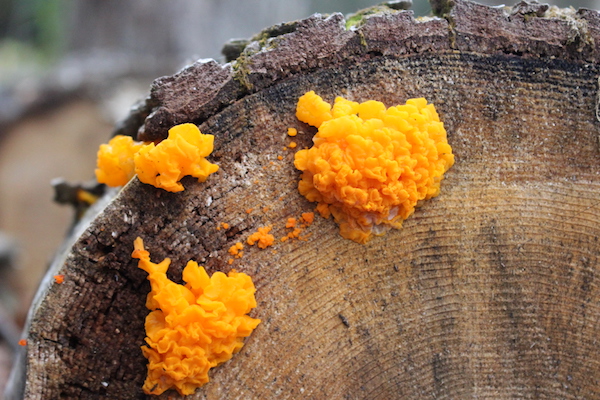
Reishi Mushrooms
Reishi mushrooms (Ganoderma sp.) are a great choice for beginner foragers. They’re easy to identify with bands of white, yellow, orange, and red and have no poisonous lookalikes.
They grow on dead or dying trees. You can usually find them on the same trees or logs year after year!
These mushrooms are too tough to eat, but they are powerful medicinals. Reishi’s are sometimes known as lingzhi, mushroom of immortality, ten-thousand-year mushroom, or herb of spiritual potency.
Herbalists consider reishi mushrooms adaptogens, meaning that they help the body cope with physical or mental stress. They may also have analgesic, anti-inflammatory, antibacterial, antiviral, antioxidant, anti-allergic, and anti-tumor properties, making them a great choice for healthy teas and tinctures.
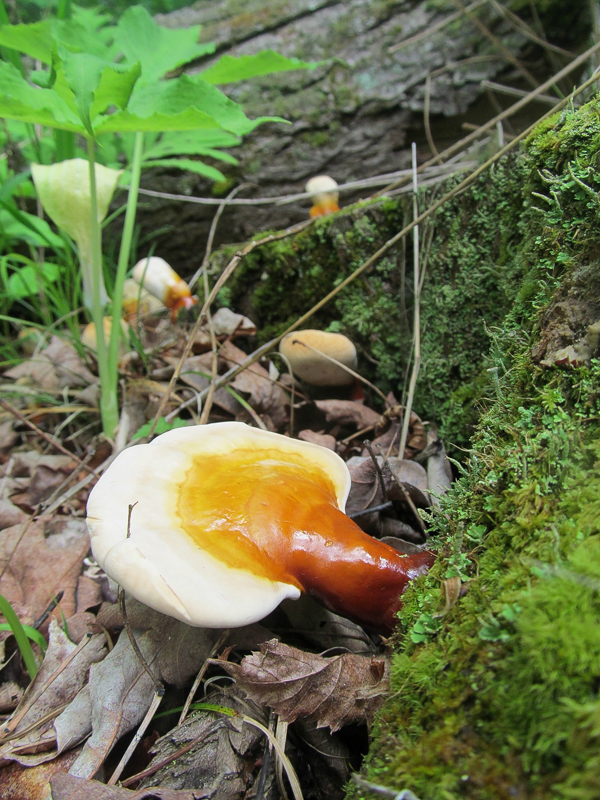
Spring Mushrooms for Intermediate Foragers
These are still pretty easy to identify, but they do require a bit more work than the “beginner” mushrooms listed above.
Oyster Mushrooms (Pleurotus sp.)
There are many species of oyster mushrooms, all of which are edible and tasty. I love them sauteed and then tossed onto pizza, pasta, or stir fry dishes. They fruit at different times of year, making this one of the mushrooms you can find during any season.
They grow on dead trees in overlapping clusters. Their caps are smooth white, tan, or gray and may be small or grow up to 10 inches across.
Oyster mushrooms are somewhat unique in that they’re carnivorous. They feed on nematodes, a type of worm, in the damp logs they grow on. For this reason, oyster mushrooms are a good source of protein.
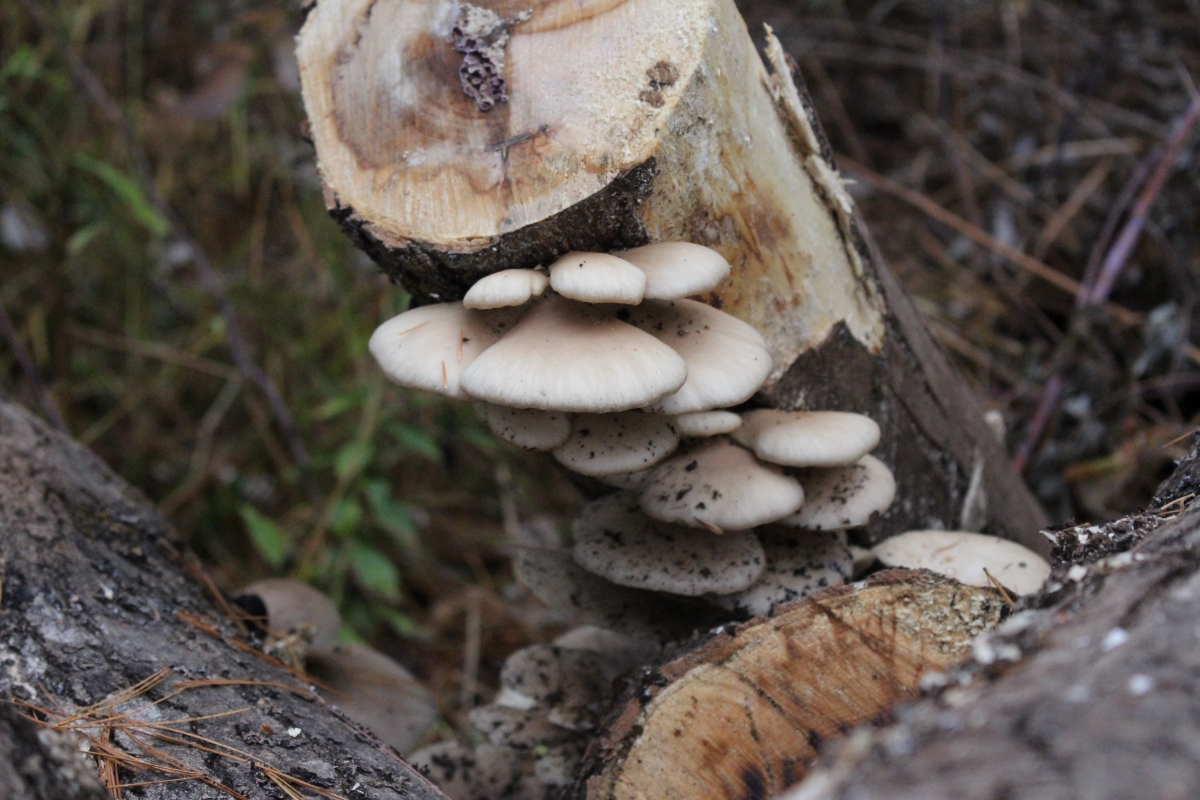
Turkey Tail Mushrooms (Trametes versicolor)
Turkey tail mushrooms (Trametes versicolor) are another one of my favorite medicinal mushrooms for making tinctures. Herbalists often use turkey tail to boost the immune system and there’s a lot of newer research being done on the use turkey tail to aid in the treatment of cancer, HPV, and other serious diseases.
Once you learn to recognize a few key features, turkey tail mushrooms are easy to identify. They’re generally easy to find, too, growing year-round on logs. Their ease of collection is astounding, considering how expensive they are to purchase.
If you’re interested in herbal medicine, learning to find your own turkey tail may save you a lot of money.
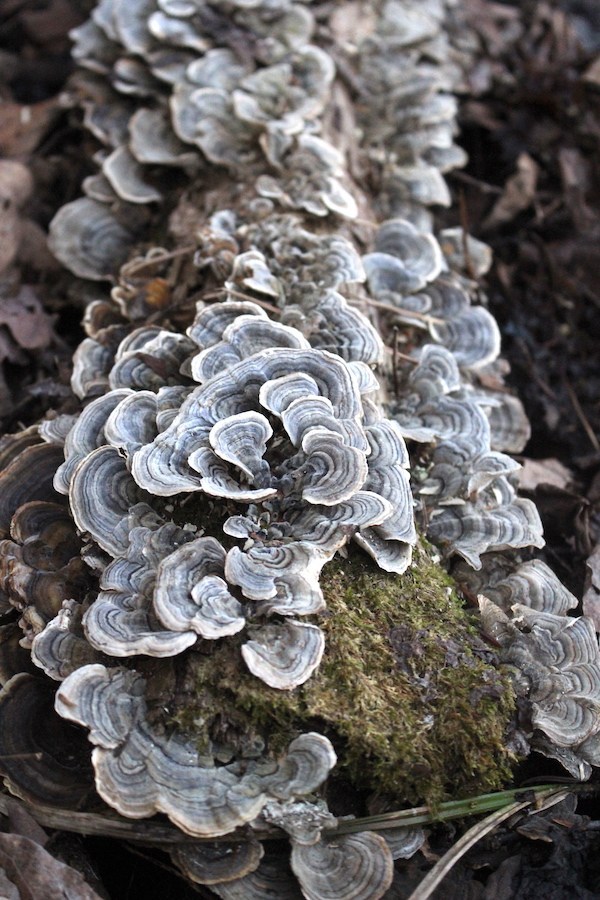
Yellowfoot Chanterelles (Craterellus tubaeformis)
These mushrooms are often overshadowed by their cousin, the golden chanterelle, but you don’t want to miss these. They have great flavor and are easy to identify.
Yellowfoot chanterelles are trumpet-shaped and have a bright yellow, hollow stem that gives them their “yellowfoot” name. They grow from the soil or heavily decomposed logs in moist, boggy areas.
Those in the western United States tend to fruit in late winter and early spring, while those in the eastern United States fruit in later summer and fall.
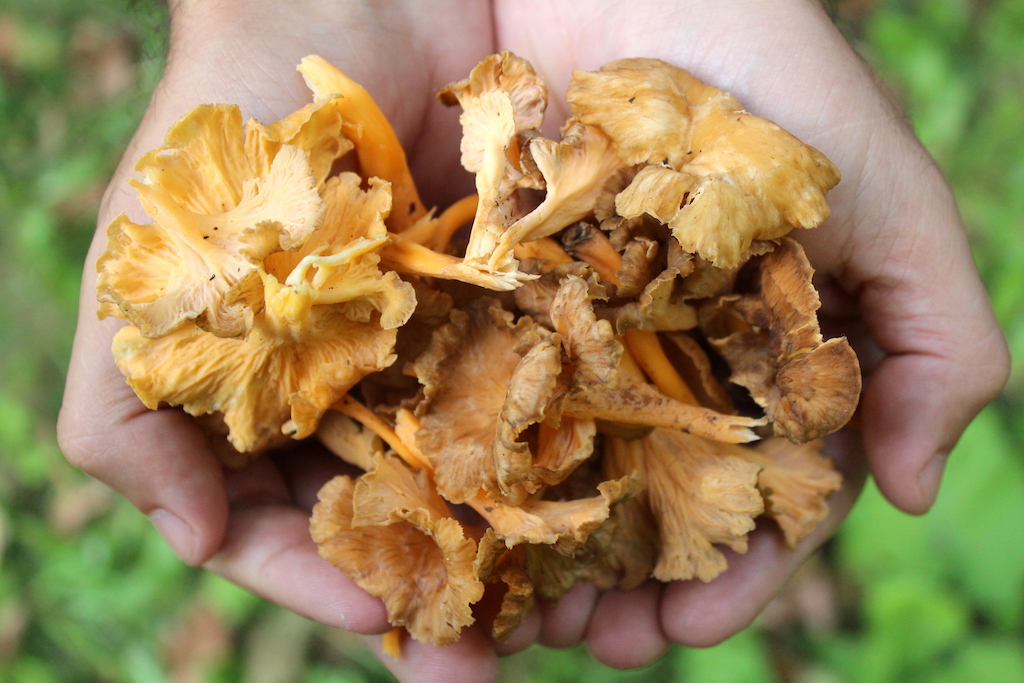
Chanterelle Mushrooms (Craterellus spp.)
Chanterelle mushrooms are among the most prized edible mushrooms. They have a wonderful meaty texture that holds up well to cooking and a flavor that’s slightly fruity, nutty, and peppery.
These beautiful mushrooms have mycorrhizal relationships with trees and need mature forests to grow. This makes them difficult to cultivate, making them a pricey treat at farmer’s markets!
Their bright orange or yellowish color makes them easy to spot on the forest floor. However, some toxic lookalikes exist, so it’s important to learn the key features to identify them.
These are usually summer mushrooms in northern climates like mine, but sometimes we find them earlier in warm years. They’re available in the spring in the Pacific Northwest and Southern US.
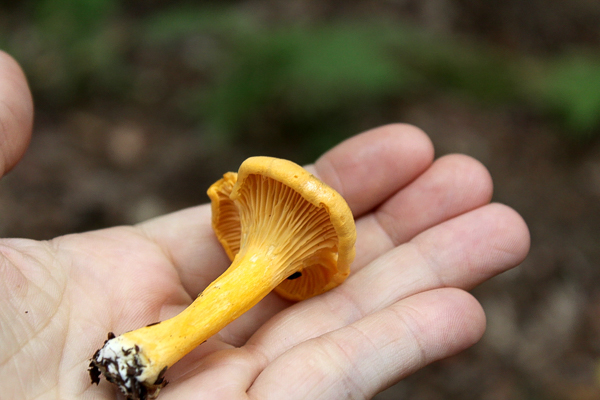
Boletes (Boletus sp.)
Boletes are among the most sought-after edible wild mushrooms, especially the king bolete, with its large bread-bun-shaped cap and nutty flavor. These mushrooms are generally easy to identify, but there are a few toxic species. It’s critical to be sure about your identification of any bolete before eating it.
Another cool thing about boletes is that they can be found almost anywhere. They are distributed throughout the northern hemisphere and in a diverse range of forest types.
Boletes are easy to eat, too. They’re wonderful browned in butter or oil with a bit of garlic, salt, and pepper. They’re also excellent after they have been dried, which really concentrates their flavor.
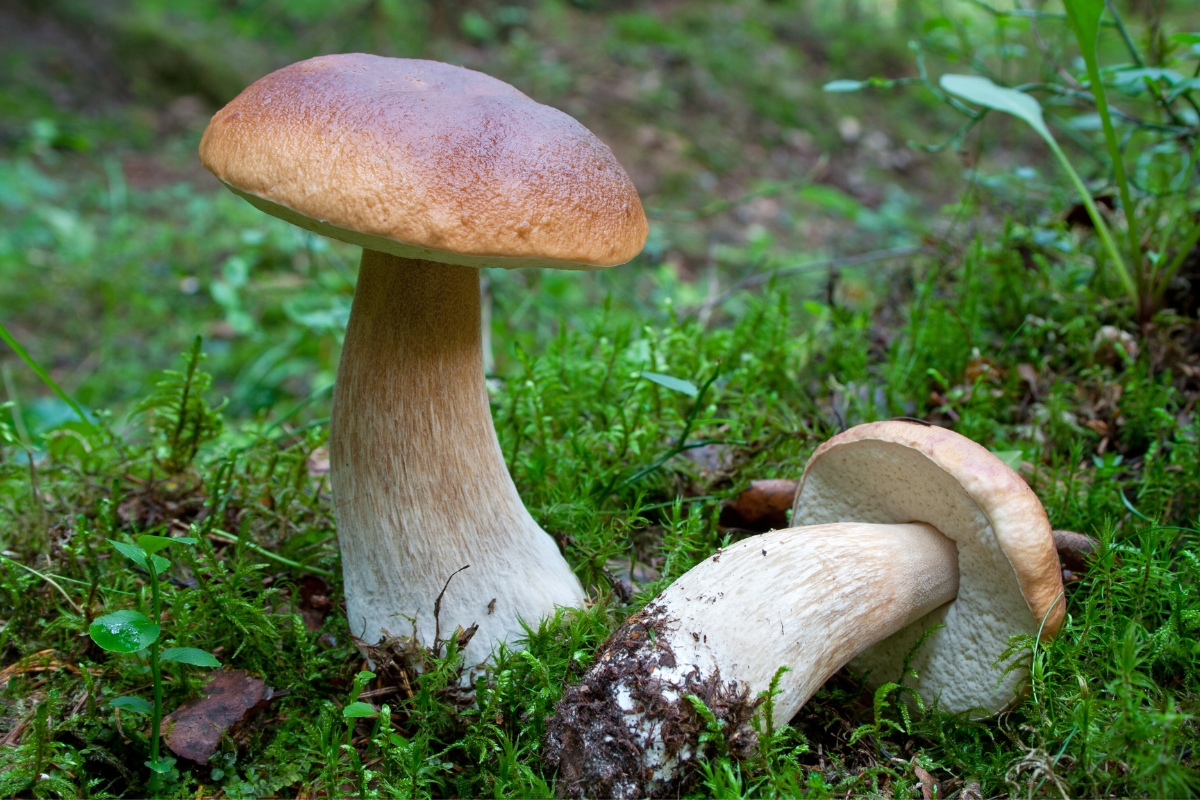
Wood Ear Mushrooms (Auricularia sp.)
Wood ears are prized in some Asian cultures for their culinary and medicinal value. Once you’ve tried them, you’ll understand why. They have a delicious flavor and unique texture, unlike any other mushroom you’ve eaten.
Wood ear mushrooms are typically brownish and translucent. As the name suggests, they look like human ears sprouting from the dead wood they grow on.
Wood ears are one of the mushrooms you can find year-round. They’ll fruit in a wide range of conditions, from cold and wet to hot and dry.
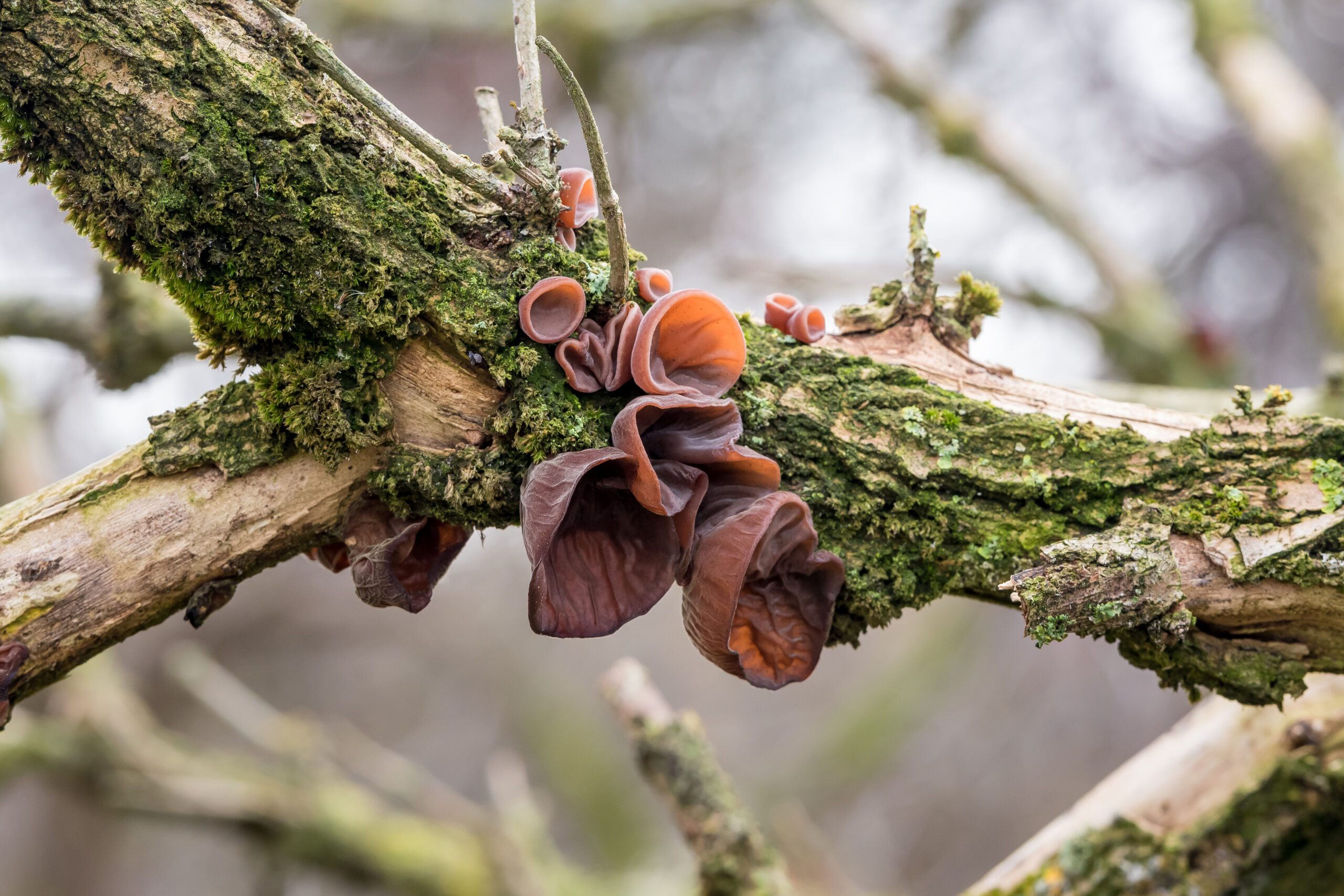
Deer Mushrooms (Pluteus cervinus and Pluteus pestatus)
Foragers don’t generally consider these prize culinary mushrooms, but they are edible and pop up throughout the year. They’ll often fruit from early spring to fall and sometimes in the winter in mild climates.
Deer mushrooms are usually some shade of brown or tan and form on dead wood. Usually, P. cervinus grows from dead logs in the woods. P. pestatus often grows from woodchips and buried wood in yards and urban areas.
As they don’t offer a ton of flavor, I find them best sauteed with plenty of aromatic herbs.
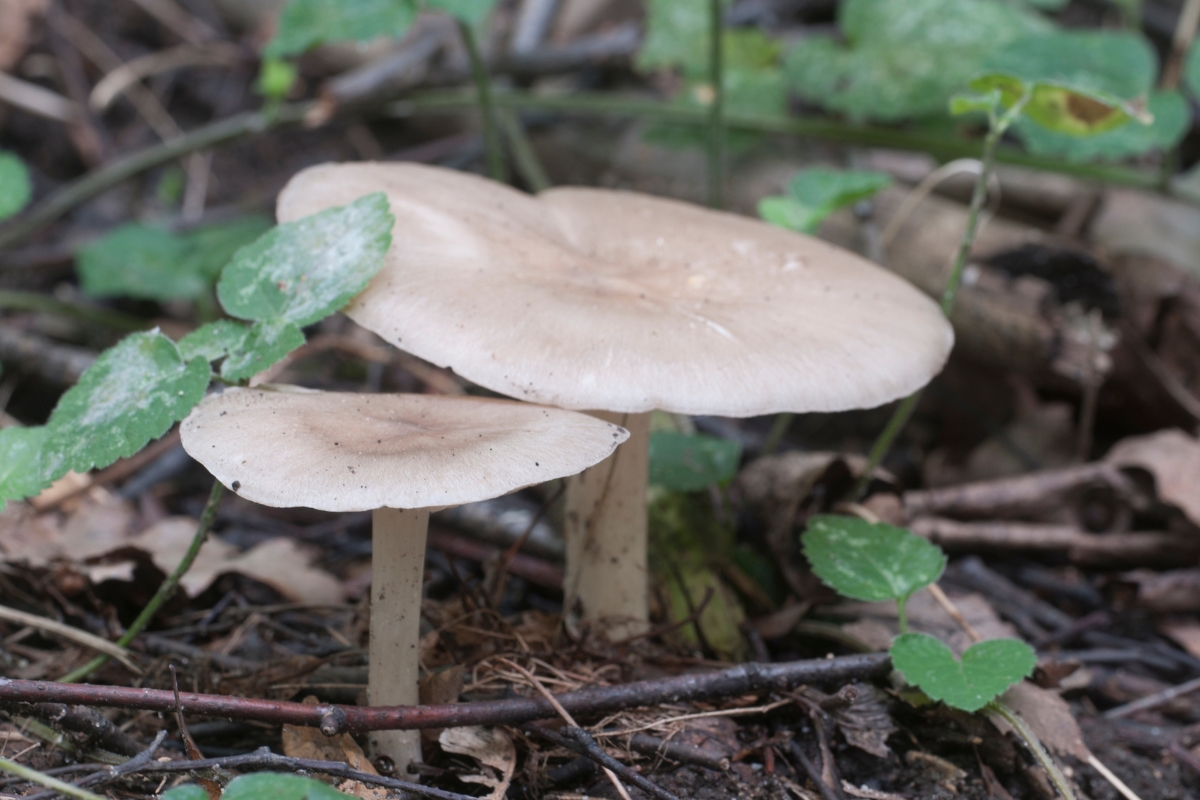
Common Split Gill Mushrooms (Schizophyllum commune)
You may have seen Split Gill Mushrooms (Schizophyllum commune) before without realizing that they were edible. Common split gills are tiny white, hairy, fan-shaped mushrooms that grow in clusters on dead branches.
Despite their somewhat leathery texture, split gills are a popular culinary mushroom in India and South America. They have a strong umami flavor. Dried and powdered, split gills have been considered a healthy alternative to MSG.
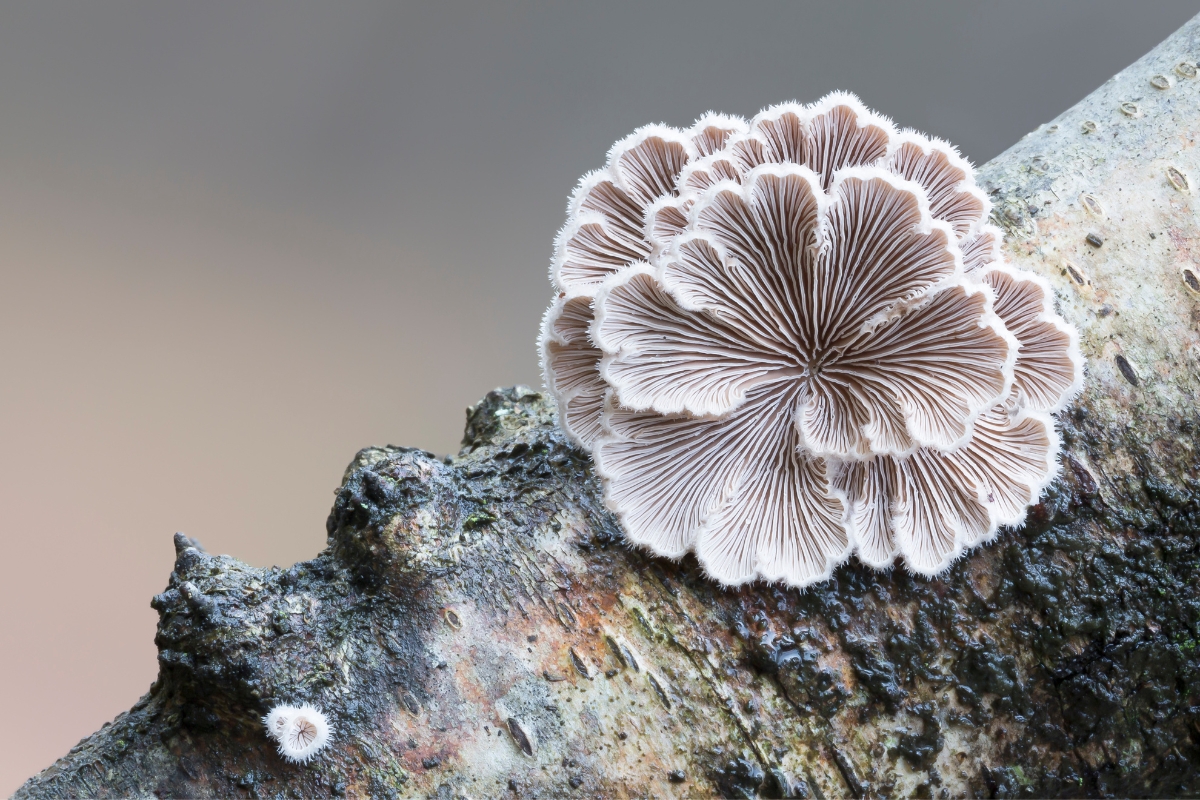
Spring Agaric Mushrooms (Agaricus bitorquis)
Spring agarics are sometimes called pavement or playground mushrooms for their odd habits. They often grow in compacted soils, sometimes where salt is applied in winter. You might even see them fruiting through cracks in the pavement!
Spring agarics are a choice edible mushrooms with classic “mushroomy” flavor. Their odd habitat makes them a good choice for urban foragers. However, they can bioaccumulate toxins, so harvesting them away from roadsides and other contaminated areas is best.
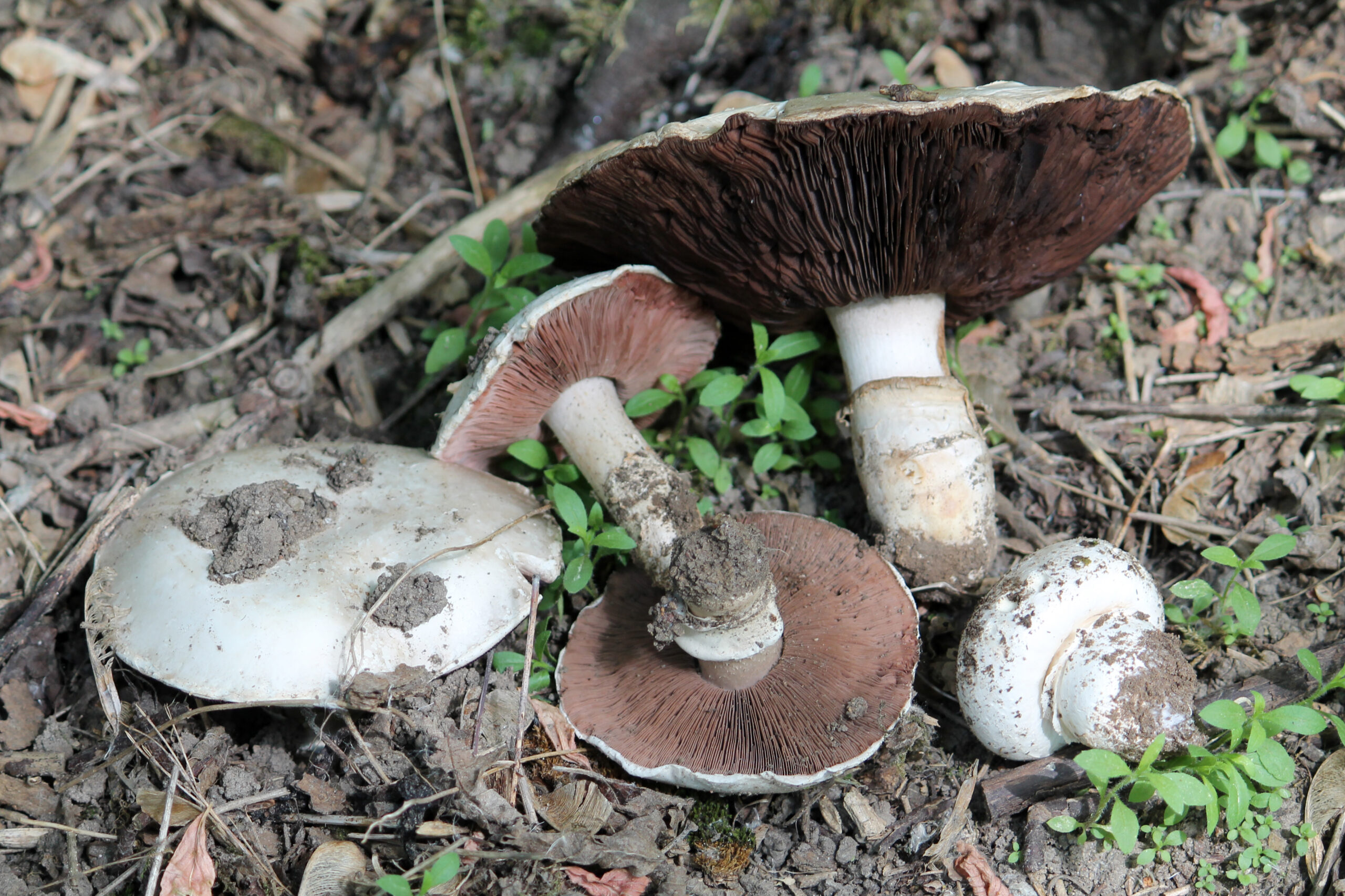
Advanced Spring Mushrooms (Not For Beginners!)
I’m including these mushrooms for completeness, but they’re definitely not for beginning foragers. Many have deadly toxic look-alikes, and some are only edible in certain circumstances. These are not for casual or beginning foragers!
Caesar Mushrooms (Amanita caesarea, and other edible amanita species)
Jackson’s slender caesar mushrooms grow in pine and oak forests. They’re incredibly easy to spot, as their caps have brilliant red centers that fade to orange or yellow on the outside.
Despite their bright appearance, foragers consider these mushrooms to be a choice edible. However, especially for new foragers, it’s easy to confuse Jackson’s slender caesar mushrooms with deadly lookalikes, including other toxic amanitas.
Don’t use these mushrooms unless you are 100% certain of your identification.
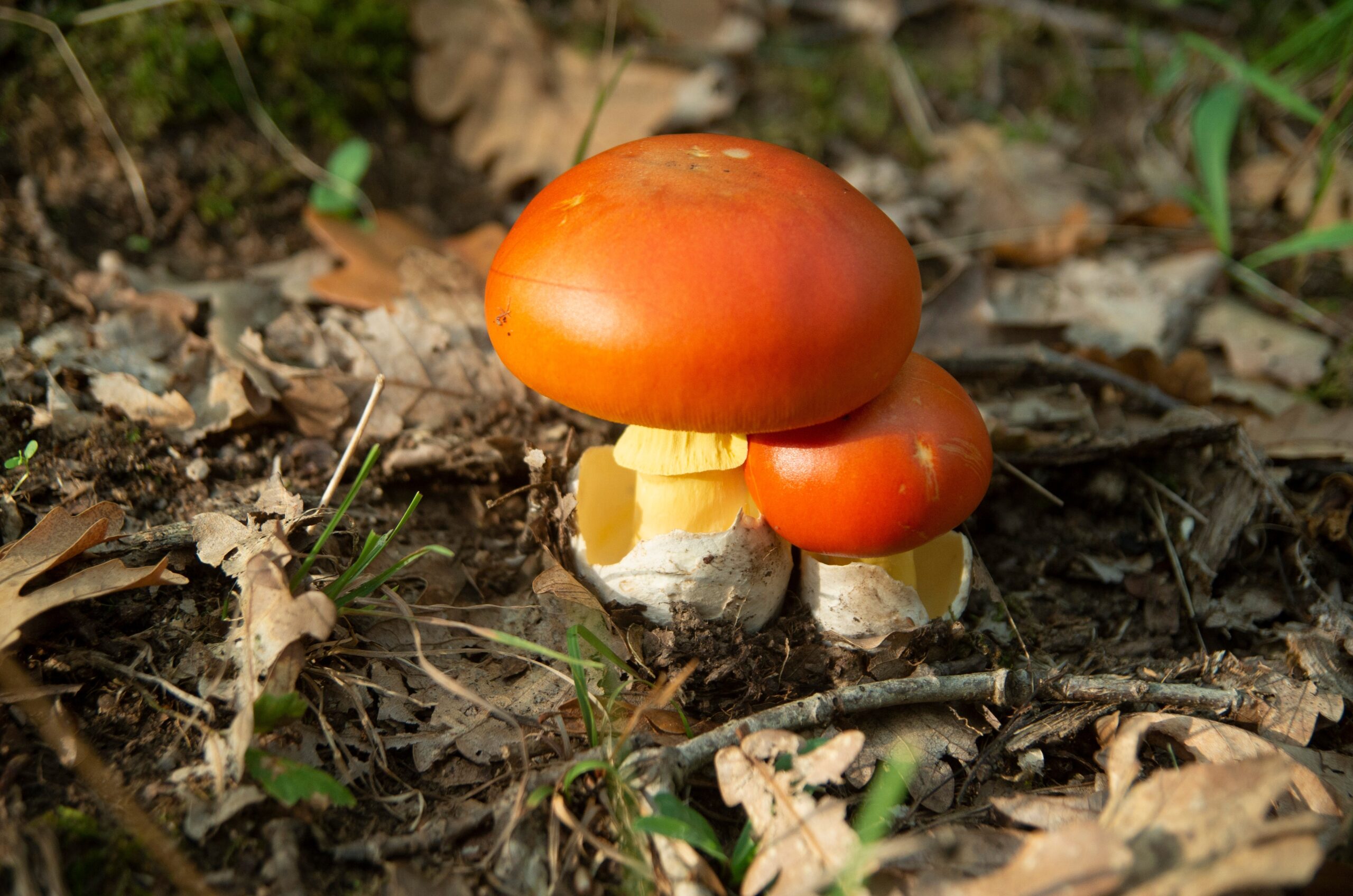
Velvet Foot or Wild Enoki (Flammulina velutipes)
Wild Enoki are incredibly widespread, small red or brownish mushrooms that grow in clusters on decomposing hardwood. They’re extremely cold-hardy and, in some areas, will fruit year-round.
While they look more colorful, they taste the same as cultivated Enoki. Normally, the Enoki you find in stores and restaurants has been grown in dark conditions to create long, pale stems.
Take care when foraging for Enoki. These mushrooms can only be identified by their spore print, and there are many toxic lookalikes. Don’t chance it if you’re unsure about your identification!
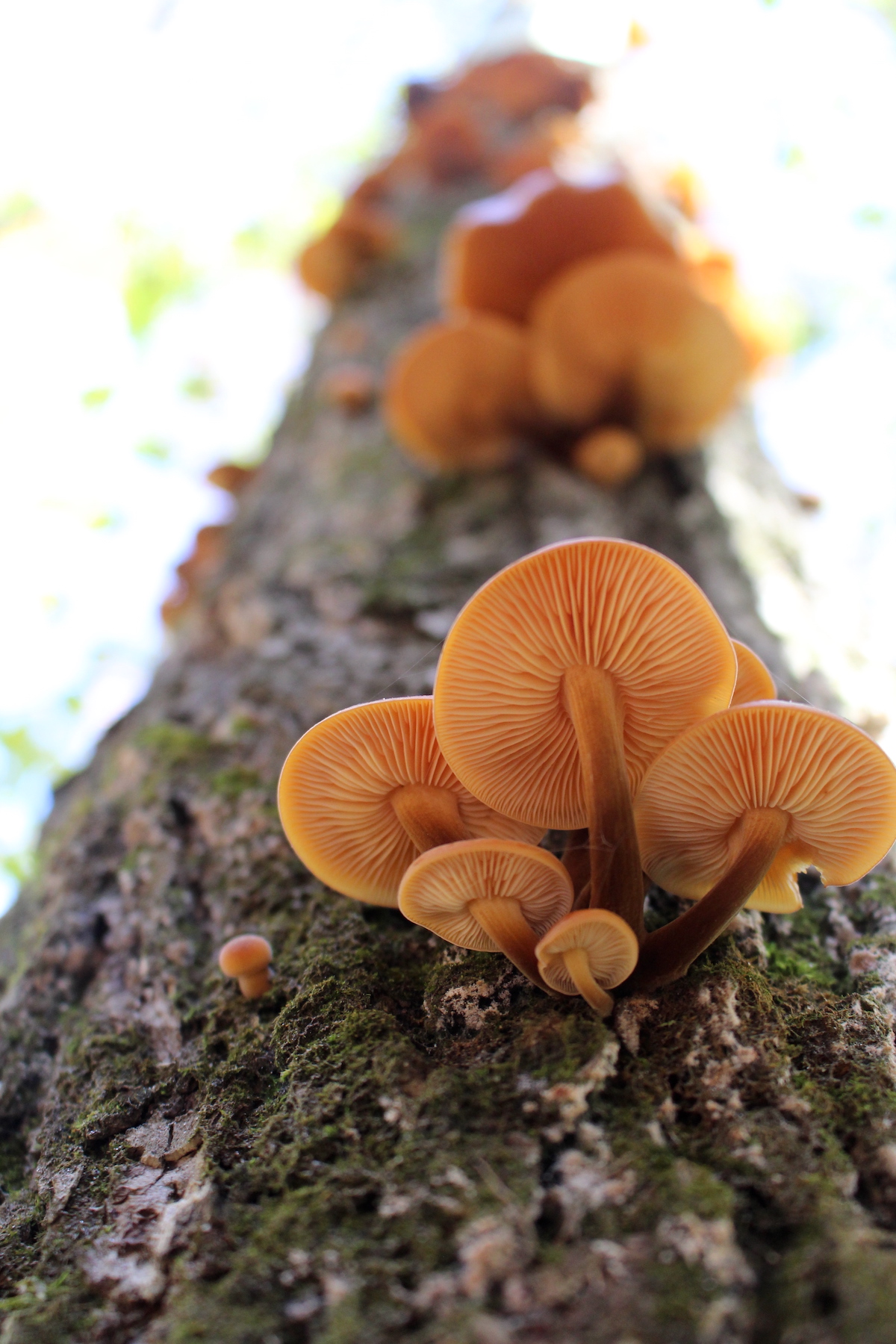
False Morels (Gyromitra spp.)
These are a controvertial mushroom, with some sources claiming they’re highly toxic, while others claim they’re edible. We don’t eat these personally, out of an abundance of caution, but I know quite a few other foragers who do.
There’s actually some evidence that tolerance to these mushrooms may be genetically inherited, as they’re incredibly common and popular in Nordic countries…but tend to be toxic to foragers from more southern bloodlines. In any case, regardless of who your ancestors are, they still need to be prepared properly and cannot be eaten raw.
I’m inlcuding these for completeness, as many other guides include them (but without a word of caution). It’s amazing that the same mushroom that’s sold by the bucketload in some countries is responsible for more mushroom poisonings than any other in others. Again, proceed cautiously, and I don’t personally recommend eating these.
Don’t treat these mushrooms like ordinary morels! They’re extremely toxic unless prepared correctly. They should only be used by experienced foragers. They’re a fun mushroom to know and identify, but for most people, appreciating their unusual appearance is enough.
Most of the false morel or Gyromitra species contain a compound called Gyromitrin, which the human body metabolizes into Monomethylhydrazine, a major component in rocket fuel.
Oddly enough, these mushrooms are sometimes called “beefsteak mushrooms,” and people regularly eat them in Michigan’s Upper Peninsula and parts of Scandinavia, Germany, and Eastern Europe.
To make these mushrooms safe, people usually blanch them in boiling water, but even the fumes are toxic, so this needs to be done outside or under a vent hood.
While people do eat them, it’s best to leave it to the experts. Fatalities have occurred when people have mis-prepared false morels.
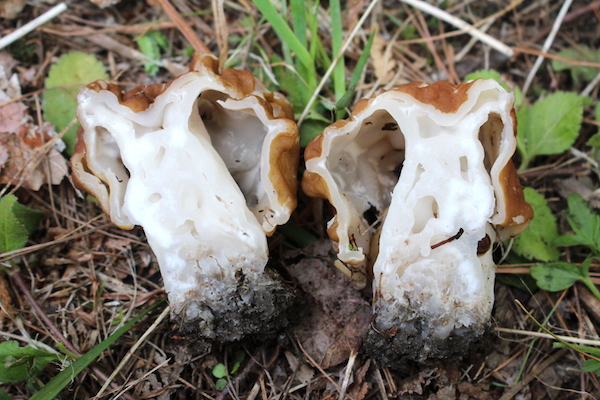
Springtime Amanita (Amanita velosa)
Foragers on the West Coast can also keep their eyes open for the springtime amanita (Amanita velosa). While this mushroom may have incredible flavor, it’s also very tricky to distinguish it from other amanitas, including the Deathcap (Amanita phalloides) and the Destroying Angel (Amanita ocreata).
Only expert mushroom foragers should consume springtime amanita. I don’t consume these personally, and I am simply including them for completeness as other foraging guides list them…but without cautions.
These mushrooms have a mycorrhizal relationship with oak trees. Usually, you can find them growing from the ground on the edges of oak woodlands.
Mushroom Foraging Ideas
Looking for more mushrooms to forage this season?
